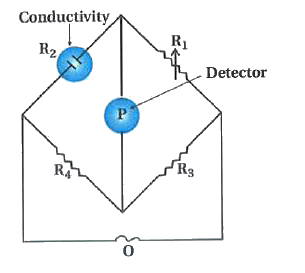Explain measurement and calculation of resistivity of electrolytic solution.
Text Solution
* First, determine conductivity cell constant (G∗).
By using this cell measure the resistance and ionic conductivity of any solution.
* (A) Measurement of resistance of solution : The set up for the measurement of the resistance is shown in the figure below:

* It consists of two resistances R3andR4, a variable resistance R1 and the conductivity cell having the unknown resistance R2. the Wheatstone bridge is fed by an oscillator O (a source of a.c. power in the audio frequency range 550 to 5000 cycles per second).
* P is a suitable detector (a headphone or other electronic device) and the bridge is balanced when no current passes through the detector.
* (B) Calculation for resistance of solution : In this condition, unknown resistance of unknown solution is obtained by following formula:
(R2=R1R4R3=R)
* These days, inexpensive conductivity meters are available.
* Electric resistance R is measured in ohm which has Ω symbol.
(R=ρ(lA)=1κ(lA)=G∗κ)
Where, R=Resistance
G∗=Cell constant=G∗=lA
ρ=Resistivity
κ (kappa)=Conductivity of solution.
|
Topper's Solved these Questions
- ELECTROCHEMISTRYBOOK - KUMAR PRAKASHANCHAPTER - ELECTROCHEMISTRYEXERCISE - SECTION-A (Try Yourself)
25 Videos
- ELECTROCHEMISTRYBOOK - KUMAR PRAKASHANCHAPTER - ELECTROCHEMISTRYEXERCISE - SECTION-A (Practice Questions)
3 Videos
- ELECTROCHEMISTRYBOOK - KUMAR PRAKASHANCHAPTER - ELECTROCHEMISTRYEXERCISE - SECTION-E MCQ.s Asked in GUJCET/Board Exam
55 Videos
- CHEMISTRY IN EVERYDAY LIFEBOOK - KUMAR PRAKASHANCHAPTER - CHEMISTRY IN EVERYDAY LIFEEXERCISE - SECTION - E (MCQs ASKED IN GUJCET/BOARD EXAM)
37 Videos
- GENERAL PRINCIPLES AND PROCESSES OF ISOLATION OF ELEMENTSBOOK - KUMAR PRAKASHANCHAPTER - GENERAL PRINCIPLES AND PROCESSES OF ISOLATION OF ELEMENTSEXERCISE - SECTION - E (MCQs ASKED IN GUJET/BOARD EXAMS)
46 Videos
Similar Questions
Knowledge Check
The resistance offered by electrolytic solution of a cell is
AimpedanceBreactanceCinternal resistance of cellDadmittanceMeasurement of the coonductivity of electrolytic solutions is done with the helpof Wheatstone bridge using a/an
AbatteryBinduction coilCconductivity cellDboth (2) and (3)For measuring the conductivity of an electrolyte its solution should be prepared in
ATap waterBDistilled waterCConductivity waterDPolywater.
Why is alternating current used for measuring resistance of an electrolytic solution?
View SolutionWhy is alternating current used for measuring resistance of an electrolytic solution ?
View SolutionWhy is alternating current used for measuring resistance of an electrolytic solution ?
View SolutionIt is practically difficult to calculate the equivalent conductivity of a weak electrolyte in aqueous solution. Comment.
View SolutionConductance of a solution of a strong electrolyte is measure of its
View Solution
